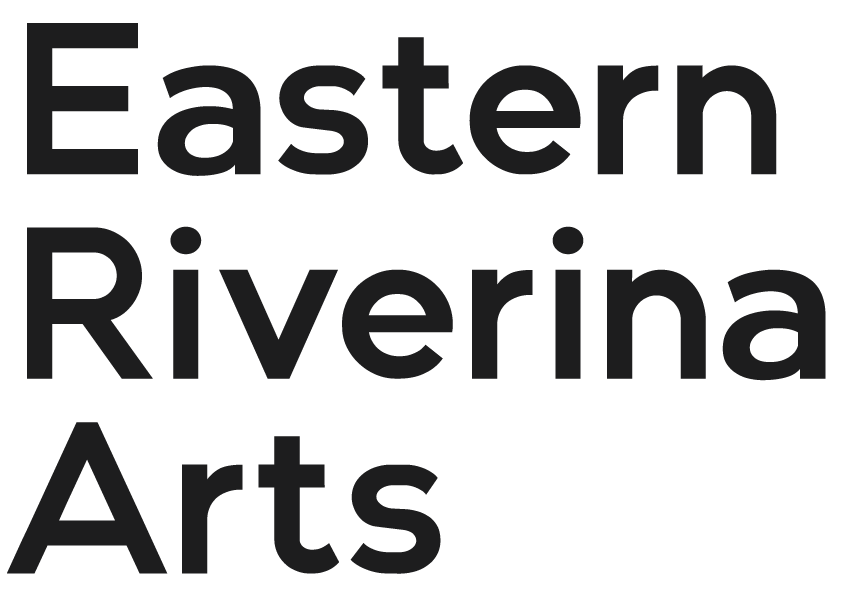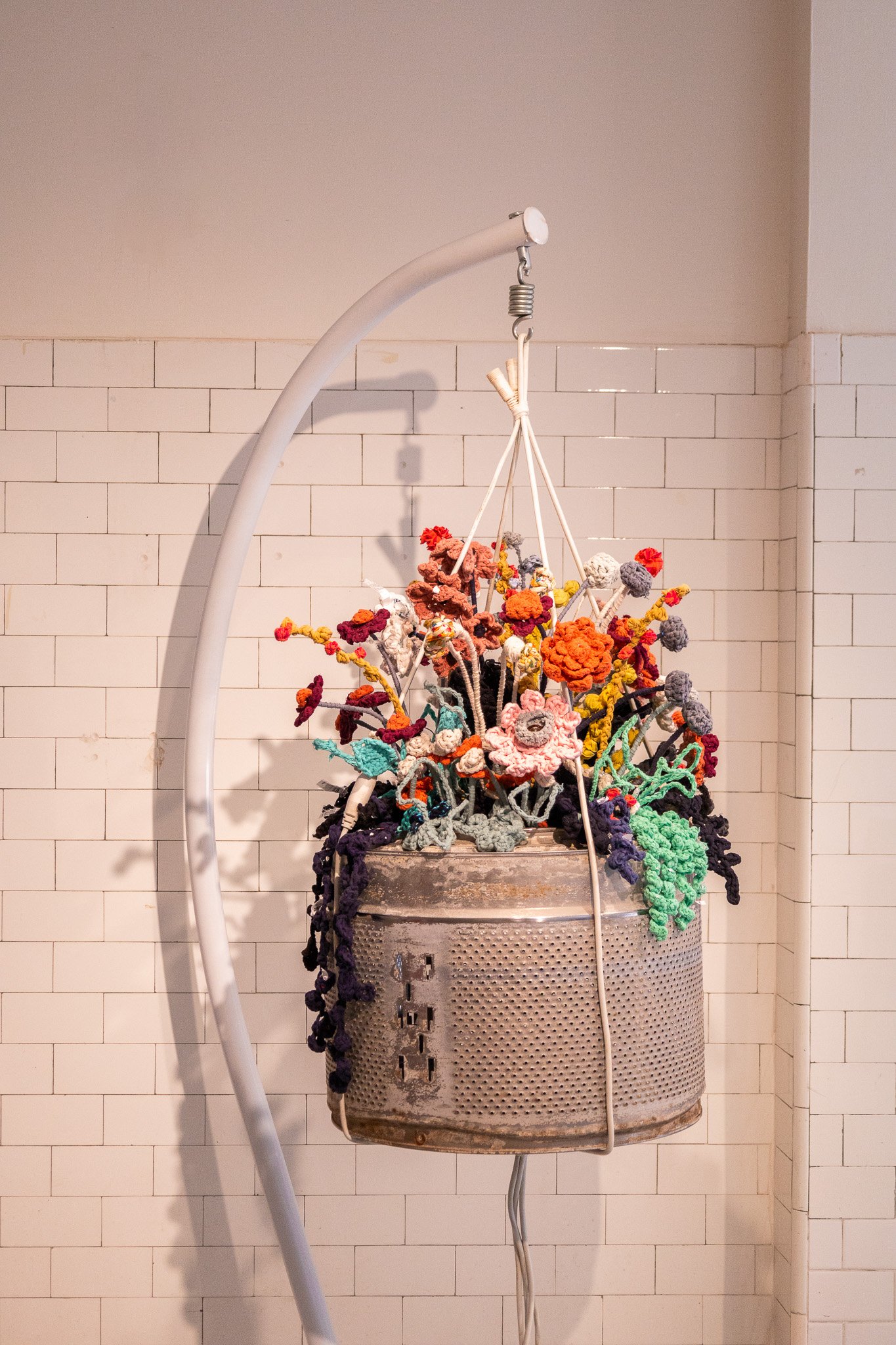The C(raft) Word: Craft in Response to Gender and Representation
Historically associated with the home and hobbies of women, craft is frequently dismissed and devalued as an artform. Today, artists working across contemporary craft and design still encounter this gendered prejudice towards the medium. Together these works highlight the important role of women in shaping the past, present and future of craft as an artform - illustrating the ways craft is being used time and time again to embellish and embroider the mundane, shape and rebuild memory, demand change and repair what is broken.
This exhibition was supported through the Wagga Wagga City Council Annual Grants Program.
Artists and Artworks:
EMILY SHANNON
Mother Craftist 2024
T-shirts, washing machine drum, power cords, wire
Mother Craftist is a deeply personal artwork made from a load of washing, parts of a washing machine, and buttons inherited from the artist’s Grandmothers Bobette & Nancy. Tired t-shirts donated by the artists children have been cut and crocheted to form an energetic explosion of life.
The artist chose to be a stay-at-home Mum for 10 years; for from this gift of time to creatively play alongside her kids and to craft with the resources around her, her creativity bloomed... leading to a career transition from a physiotherapist to artist!
The opportunity to emerge from homemaking as an artist was not afforded to her grandmothers, as they lived at a time when their resourcefulness and creative skills was no more than a necessary part of economic survival. This artwork is dedicated to them.
PENNY KING
Facets 2024
Hand embroidered linen and cotton, vinyl and denim
My Grandmother always wore an apron; it was her uniform, suit of armour... her talisman. One of the last things she said to me that stuck in my mind is “women work so much harder now”, in comparison to her own generation.
This apron’s facets represent women’s identities evolving, recognising changing priorities, status in society and demands on our time expressed through the use of vintage and modern textiles and design.
Embroidered table cloth – the time given to nurturing the home; embroidered apron – the time given to nurturing the family; flour bag – time given to nourishing the family; voile – our evolving identities; printed linen – modern convenience; red vinyl – modern demands on our time.
We are being recut, we are adding more facets to our form, we are brilliant.
MARY EGAN
Ahh Crumbs (Bread and Roses) 2024
Acrylic and Woolen yarn, stranded colourwork knitting and duplicate stitch embroidery
In 1912 workers at a textile mill in Lawrence USA went on strike led by immigrant women calling for “bread and roses”. The slogan captured these women’s demands; they wanted bread, symbolic of the necessities of life, but also roses, that which allows a person to flourish such as art, pleasure and community. Today their demand still feels urgent. Paid work is precarious, domestic work proliferates and despite the crushing workload, there is a feeling of being left with just the crumbs.
My work takes up this slogan to reflect on the marginalization of women's work. Images of endless work, domestic and formal, weigh down the ‘Bread’ jumper while the ‘Roses’ jumper utilities more space with knitted and embroidered roses. Extra-long arms allude to how far we have to go in our struggle but also suggest the long reach of this story of resistance, inspiring us today. I've chosen knitting to explore this story because this craft frames resistance as an act of care for self and community. By echoing the slogan of the bread and roses strike in these soft and caring sculptures I draw attention to women's work and resistance.
GEORGIA CROWDEN
Conversations in Softness 2024
hand dyed cotton, thread, foam, glue
Familiar yet structurally unconventional, Conversations in Softness challenges viewers to reconsider domestic roles and identity through interactive engagement. This work is encouraged to be touched.
Georgia is an emerging artist currently living on Wiradjuri Country in Wagga Wagga, NSW. Her practice sits at the intersection of craft and feminism - exploring domestic space. Dining chairs are the object currently worked on, for their role as literal 'conversation pieces' in domestic environments.
They symbolise the gathering around a dining table, where stories are shared and connections are forged.
JACQUIE TINKLER
Quotidian: belonging to the day 2023
365 Stoneware pinch pots, raw clay, bisqued ceramic, glazed ceramic
The 365 pots on this table were made over the course of a calendar year, one per day. They represent the process of learning and creating, and the development of the skills and processes of crafting with clay. The intention of this work was never to make a complete work of “Art” but to engage in a creative process that had no real intent other than to practice craft as a deliberate daily ritual and to enjoy engaging with clay as a material.
Piled on a table, these small and fragile pinch pots make visible the process of learning a craft over time and what that involves: the failures, the joys, the ‘letting-go’, the testing of ideas, the (lack of) patience, and the limitations and development of ability. Collectively, and retrospectively, they are pieces that are about memory, time, materiality, and coming to terms with both imperfection and progress.
TINA DE JONG
The tree of life is hanging by a tenuous thread 2024
Soft sculpture of Gingko biloba, the tree of wisdom. With pressed and dried leaves and branches from various seasons, pastels, chalk and pencil, stitching, interfacing, wire, string, specialised papers, cardboard and material.
It is hard to make a tree. There is a lesson in that for us all.
The tree of wisdom is an ephemeral, freely floating reminder that life is precious and precarious and could blow away. The work represents the role women largely play in stitching back together our ever-tenuous place in nature. Women crafting together a climate response and how necessary their nurturing, caring ways are, in recreating a society that is at one with nature. The reset in this relationship with Mother Earth that will allow us to pass these crafts onto many more successive generations.






